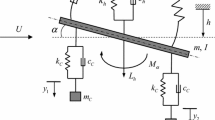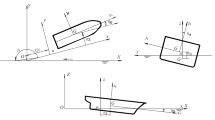Abstract
This paper investigates a calculation method for the heave and pitch motion of a trimaran, which includes direct and indirect calculation methods. In the direct calculation method, Computational Fluid Dynamics (CFD) simulation is applied to calculate trimaran motion. In the indirect calculation method, there exist three steps to achieve motion calculation: first, a standard wave spectrum is chosen to excite the wave force and moment acting on the trimaran; second, particle swarm optimization (PSO) and polynomial fitting methods are adopted to identify the function of wave force and moment; finally, the mathematical model of the trimaran is established. To compare the effectiveness of the direct and indirect methods, the model test of the trimaran is performed in a towing tank. The results of the model test proved that the direct and indirect methods are all effective for calculating the heave and pitch motions of a trimaran.




















Similar content being viewed by others
Abbreviations
- PSO:
-
Particle swarm optimization
- \(W2F\) :
-
The transfer function of wave-to-force
- \(W2M\) :
-
The transfer function of wave-to-moment
- \(F2H\) :
-
The transfer function of force to heave
- \(F2P\) :
-
The transfer function of force to pitch
- \(M2H\) :
-
The transfer function of moment to heave
- \(M2P\) :
-
The transfer function of moment to pitch
- \(L\) :
-
Length of trimaran
- \(B\) :
-
Beam of trimaran
- \(D\) :
-
Depth of trimaran
- \(T\) :
-
Draught of trimaran
- VOF:
-
Volume of fluid
- \(S_{\zeta } (\omega )\) :
-
The function of spectrum density
- \(H_{S}\) :
-
Significant wave height
- \(T_{1}\) :
-
Wave period
- \(\omega\) :
-
Circle frequency
- \(\omega_{e}\) :
-
Encounter frequency
- \(z\) :
-
Heave (m)
- ITTC:
-
International Towing Tank Conference1
- \(a_{ij}\) :
-
Added mass
- \(b_{ij}\) :
-
Damping coefficients
- \(c_{ij}\) :
-
Restoring coefficients
- \(m\) :
-
Mass of the trimaran
- \(I\) :
-
Longitudinal inertia of the trimaran
- \(F_{3}\) :
-
Wave force
- \(M_{5}\) :
-
Wave moment
- CFD:
-
Computational Fluid Dynamics
- RANS:
-
Reynolds Averaged Navier–Stokes
- \(P\) :
-
Scale ratio
- \(v\) :
-
Speed of the trimaran
- PF:
-
Polynomial fitting
- EFD:
-
Experimental fluid dynamics
- SST:
-
Shear stress transport
- \(G(s,\alpha )\) :
-
The transfer function of wave-to-force and moment
- \(B(s,\alpha )\) :
-
Numerator term of the transfer function
- \(A(s,\alpha )\) :
-
The denominator of the transfer function
- \(J(\alpha )\) :
-
The cost function
- DOF:
-
Degree of freedom
References
Kianejad SS, Enshaei H, Duffy J et al (2019) Calculation of a ship roll added mass moment of inertia using numerical simulation. Ocean Eng 173:77–89
Tezdogan T, Demirel YK, Kellett P et al (2015) Full-scale unsteady RANS CFD simulations of ship behavior and performance in head seas due to slow steaming. Ocean Eng 97:186–206
Tahsin T, Atilla, et al (2016) Full-scale unsteady RANS simulations of vertical ship motions in shallow water. Ocean Eng 123:131–145
Wu CS, Zhou DC, Gao L et al (2011) CFD computation of ship motions and added resistance for a high speed trimaran in regular head waves. Nephron Clinical Prac 3(1):105–110
Kim M, Hizir OG, Turan O et al (2017) Numerical studies on added resistance and motions of KVLCC2 in head seas for various ship speeds. Ocean Eng 140:466–476
Takami T, Matsui S, Oka M et al (2018) A numerical simulation method for predicting global and local hydroelastic response of a ship based on CFD and FEA coupling. Mar Struct 59:368–386
Bi X, Shen H, Zhou J et al (2019) Numerical analysis of the influence of fixed hydrofoil installation position on seakeeping of the planning craft. Appl Ocean Res 90:101863
Queutey P, Visonneau M (2010) RANS calculation of the KVLCC2 tanker in head waves. International Conference on Hydrodynamics
Liu Y, Zou L, Zou Z et al (2018) Calculations of ship maneuverability based on virtual captive model tests. Eng Appl Comput Fluid Mech 12(1):334–353
Dai K, Li Y (2019) Manoeuvring calculation of KVLCC2 with hydrodynamic derivatives generated by a virtual captive model test. Pol Mar Res 26:16–26
Cakici F, Kahramanoglu E, Duman S et al (2018) A new URANS based approach on the calculation of vertical motions of a surface combatant in head waves. Ocean Eng 162:21–33
Duan W, Wang S, Ma S (2019) Verification of application of the 2.5D method in high-speed trimaran vertical motion and added resistance calculation. Ocean Eng 187:106177
Pérez Arribas F, Clemente Fernández JA (2006) Strip theories applied to the vertical motions of high speed crafts. Ocean Eng 33(8–9):1214–1229
La Cruz JM, Aranda J, Gironsierra JM et al (2004) Improving the comfort of a fast ferry. IEEE Contr Sys Mag 24(2):47–60
International Towing Tank Conference Maneuvering Committee (2008) Final report and recommendations to the 25th ITTC. International Towing Tank Conference
Esteban S, Giron-Sierra JM, Andres-Toro BD et al (2005) Fast ships models for seakeeping improvement studies using flaps and T-foil. Math Comput Modell 41(1):1–24
Rocío Muoz-Mansilla (2008) Identification of longitudinal and transversal dynamics of a fast ferry. World Congress
Zhang J, Liu Z, Sun T et al (2021) Explicit stochastic model predictive control for anti-pitching a high-speed multihull. Appl Ocean Res 119:102917
Liu Z, Zheng L, Li G et al (2021) An experimental study of the vertical stabilization control of a trimaran using an actively controlled T-foil and flap. Ocean Eng 219:108224
Su Y, Shuo W, Shen H et al (2014) Numerical and experimental analyses of hydrodynamic performance of a channel type planning trimaran. J Hydro Ser B 26(4):549–557
Zheng L, Liu Z, Yang S et al (2021) Optimal design and installation of appendages for improving stability performance of a trimaran. Ocean Eng 238:109719
Perez T (2005) Ship motion control: course keeping and roll stabilization using rudder and fins. Springer, London, UK, pp 17–44
Moreira L, Fossen TI, Soares CG (2007) Path following control system for a tanker ship model. Ocean Eng 34(14–15):2074–2085
Munoz-Mansilla R, Aranda J, Diaz JM et al (2009) Parametric model identification of high-speed craft dynamics. Ocean Eng 36(12–13):1025–1038
Funding
The work of Zhilin Liu was supported by National Natural Science Foundation of China, under Grant 51379044.
Author information
Authors and Affiliations
Corresponding authors
Additional information
Publisher's Note
Springer Nature remains neutral with regard to jurisdictional claims in published maps and institutional affiliations.
About this article
Cite this article
Zheng, L., Liu, Z., Zeng, B. et al. Experimental and numerical study on heave and pitch motion calculation of a trimaran. J Mar Sci Technol 28, 136–152 (2023). https://doi.org/10.1007/s00773-022-00910-9
Received:
Accepted:
Published:
Issue Date:
DOI: https://doi.org/10.1007/s00773-022-00910-9




